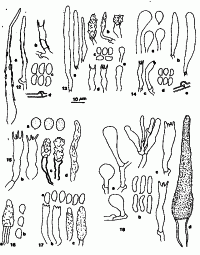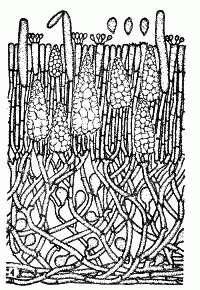|
 Chondrostereum vesiculosum Chondrostereum vesiculosum
SynonymsPeniophora vesiculosa
BiostatusPresent in region - Indigenous. Endemic
Images (click to enlarge)
Caption: Fig. 12-18 , Fig. 12 Peniophora nikau [=Subulicystidium nikau] (PDD 13816), a: cystidia,
b: basidium, c: spores,.d:
basal hypha. Fig. 13 Peniophora verecunda [=Palifer verecundus](PDD 12513), a: leptocystidia, b: encrusted
cystidia, | 
Caption: Fig. 4. Peniophora vesiculosa G.H.Cunn. Transverse section, x 500. |
Article: Cunningham, G.H. (1955). Thelephoraceae of New Zealand. Part VI. The genus Peniophora. Transactions of the Royal Society of New Zealand 83(2): 247-293.
Description: Hymenophore annual or perennial, membranous, adnate, effused forming irregular linear
areas to 10 x 6 cm, with a few scattered irregular islands; surface cream, becoming yellow-ochre,
even, finally creviced irregularly and tending to lift along the edges of the fissures;
margin thinning out, pelliculose-fibrillose, adnate, concolorous. Context white or cream, 160-400 µ
thick, basal layer broad or narrow, of parallel hyphae, intermediate layer of ascending
densely compacted hyphae and cystidia, when zoned of alternating layers of vertical and
parallel hyphae; generative hyphae 3-4.5 µ diameter, walls 0.5 µ thick, hyaline, naked,
branched, septate, with large clamp connexions. Hymenial layer to 45 µ deep, a close palisade
of basidia, paraphyses, gloeocystidia and cystidia. Basidia subclavate, 18-25 x 4-5 µ, 4-spored;
sterigmata slender, to 6 µ long. Paraphyses similar to but shorter than the basidia.
Gloeocystidia somewhat scanty, confined to the hymenial layer, projecting to 30 µ, flexuous-cylindrical,
35-46 x 5-6 µ, walls 0.5 µ thick. Vesicles confined to the intermediate layer,
numerous or scanty, pyriform, 6-12 µ diameter, walls 0-5 µ thick. Cystidia confined to the
hymenium and subhymenium, not or scarcely projecting, conical, 40-60 x 12-20 µ, coarsely
crystal coated. Spores pip-shaped, 5-6 x 2.5-3 µ, walls hyaline, smooth, 0.2 µ thick;
commonly adhering in pairs or fours.
Habitat: HABITAT. Effused on bark of dead branches and stems.
Distribution: DISTRIBUTION. New Zealand.
Notes: Three species described herein possess vesicles in addition to gloeocystidia and cystidia. In P.
vesiculosa and P. utriculosa vesicles are pyriform and arise from lateral branches of the
intermediate hyphae; in P. verecunda they are capitate and carried upon short stems arising
from the basal layer.
P. vesiculosa may be separated from the others by the coarsely crystal coated conical cystidia
confined to the hymenial region, and pip-shaped spores. Fructifications are sometimes
composed of several strata. Gloeocystidia are scanty and confined to the hymenial region,
project and are often collapsed and difficult to detect. Spores frequently adhere in pairs or
fours as in Corticium coprosmae.
Article: Stalpers, J.A.; Buchanan, P.K. (1991). Type studies of the species of Pellicularia and Peniophora described by G.H. Cunningham. New Zealand Journal of Botany 29(3): 331-340 (http://www.rsnz.org/publish/abstracts.php).
Description: Basidiome annual, resupinate, effused. In section the structure is distinctly duplex, showing a
loose white basal layer, a dense brown subhymenial layer and a cream-coloured hymenium.
Hymenophore even, rarely warted, cracked, cream-coloured to ochraceous. Hyphae hyaline, thin-
to somewhat thick-walled in the basal layer, 2-4(-4.5) µm, with distinct clamps. Vesicles stalked,
in the basal layer up to 12 µm diam., in the upper layer up to 7(-8) µm diam., often with resinous
contents. Clusters of crystals present in the trama, sometimes mimicking cystidia. Hymenial
cystidia clavate, thin-walled, smooth or rarely finely encrusted, 30-50 x 5.5-6.5 µm, with hyaline
or sometimes refractive material. Basidia narrowly clavate to nearly cylindrical, sometimes
sinuous, 18-25 x 4-5 µm. Spores hyaline, thin-walled, smooth, ellipsoid to slightly flattened,
4.5-6(-6.5) x 2.5-3 x 3-4 µm, not amyloid.
Notes: The species belongs to Chondrostereum Pouzar because of the duplex structure, the vesicles, the
hymenial structure and the narrow basidia. It is close to C. coprosmae (G.H. Cunn.) Stalpers,
another species of this genus endemic to New Zealand.
|